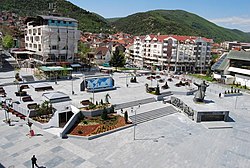Astraion
|
Strumica Струмица |
|||
|---|---|---|---|

Goce Delčev Square
|
|||
|
|||
| Location within Macedonia | |||
| Coordinates: 41°26′N 22°38′E / 41.433°N 22.633°ECoordinates: 41°26′N 22°38′E / 41.433°N 22.633°E | |||
| Country |
|
||
| Municipality | Strumica Municipality | ||
| Founded | 1920 | ||
| Government | |||
| • Mayor |
Zoran Zaev (SDSM) |
||
| Elevation | 230 m (750 ft) | ||
| Population | |||
| • Total | 35 311 | ||
| Time zone | CET (UTC+1) | ||
| • Summer (DST) | CEST (UTC+2) | ||
| Postal code | 2400 | ||
| Area code(s) | +389 34 | ||
| Car plates | SR | ||
| Patron saints | Holy Fifteen Hieromartyrs of Tiberiopolis | ||
| Climate | Cfa | ||
| Website | www.strumica.gov.mk | ||
Strumica (Macedonian: Струмица [ˈstrumit͡sa]) is the largest city in eastern Republic of Macedonia, near the Novo Selo-Petrich border crossing with Bulgaria. About 100,000 people live in the region surrounding the city. It is named after the Strumica River which runs through it. The city of Strumica is the seat of Strumica Municipality.
The town is first mentioned in the 2nd century BC with the Hellenic (Greek) name Αστραίον (Astraîon, Hellenic for "starry") by Ptolemy and Pliny. It was later known as Tiveriopolis; it received its present name from the Slavic settlers of the Middle Ages. In modern Greek the town is known as Στρώμνιτσα (Strómnitsa), and its name in Turkish is Ustrumca.
Strumica is located in the southeastern part of the country, close to the borders with Greece (15 km) and Bulgaria. It is situated in the geographical region of the Strumica Field, where the field meets the highland elevating into the Plavuš (west) and Belasica (south) mountains. The Struma river flows north of the city, while several tributaries flow through the city area.
According to archeological findings, settlements date back to 6–5000 BC, a Neolithic settlement (Stranata) located near the village of Angelci, as well as findings from the Emperor's Towers site near Strumica, where traces of a prehistoric culture existed from the early 4th to mid 3rd millennium BC were discovered. The area was populated later by the Paionians.
The first mention of the city under the name Astraion is in the writings of the Roman historian Titus Livius in 181 BC regarding the execution of Demetrius, brother of the Macedonian king Perseus (179–168 BC), son of Philip V of Macedon (221–179 BC). The name Astraion came from the Paionian tribe called Astrai. In 168 BC Macedonia became a Roman protectorate and was subsequently divided into four regions (meridas). Astraion fell into the second merida. In 148 BC Macedonia became a Roman province. In the Roman period the city changed its name to Tiveriopolis, which is evidenced by a marble statue base dedicated to the patron Tiberius Claudius Menon, who lived between the late 2nd and early 3rd century AD. During the reign of the Roman emperor Julian the Apostate (361–363 AD), the fifteen holy hieromartyrs of Tiveriopolis were killed. In 395, the Roman Empire split, and Macedonia fell under the Eastern Empire. After that, Tiveriopolis became part of the province Macedonia Salutaris in the late 4th century and part of Macedonia Secunda in the late 5th century. The urban mansion Machuk dating from the late ancient period today stands witness for the existence of a city settlement from that time.
...
Wikipedia



